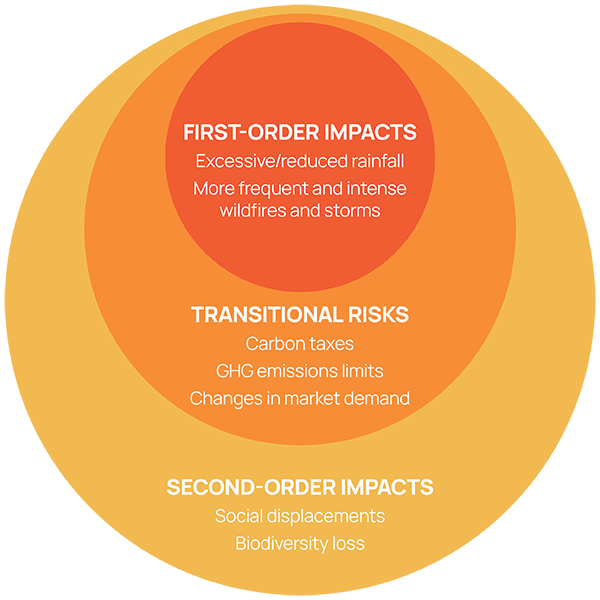With global warming wreaking havoc across the planet via increasingly unbearable heatwaves and creating ideal conditions for catastrophic events such as major wildfires, there has been a rapid and urgent focus on reducing greenhouse gas (GHG) emissions to avoid conditions worsening at an ever-greater rate.
Increasing public awareness of the global warming issue has led to escalated pressure on organizations to reduce their carbon emissions, and in many cases, investors and stakeholders now seek to know how organizations are managing their GHGs and associated climate change risks.

These climate change-related risks include:
- First-order impacts – physical impacts and transitional risks that directly affect operations, supply chains or markets. Examples of such physical risks include excessive or reduced rainfall, and more frequent and intense wildfires and storms. Transitional risks include carbon taxes, limits to the amount of GHG emissions allowed by an entity, and/or change in the market demand for products and services.
- Second-order impacts – classified as climate hazards that affect the broader economic, human, or natural environment, such as social displacements or biodiversity loss.
The full effects of climate change on business are unknown at this point, but may include disruptions to operations (direct and indirect), increased raw and processed material costs, and higher overall insurance premiums.
The role of software in carbon emissions reduction
Carbon footprint management software can digitally transform your sustainability practices, improving your ability to reduce your GHG emissions.
Here are five ways in which software can assist you to achieve your carbon reduction targets.
1. Carbon source identification and emissions data gathering
In order to reduce your carbon footprint, setting a good foundation is key. A worthy place to begin is by identifying your organization’s carbon generating activities and collecting as much accurate and complete information on these as possible.
Carbon emissions software provides a central repository for storing all your GHG emissions information, and minimizes the inaccuracies and inefficiencies that often accompanies siloed data. It may also contain features that aid in capturing vital information such as electronic data collection and reporting forms.
Because the software is centralized, there is also scope for internal employee/department access and collaboration to further improve the accuracy, consistency, and fullness of the carbon data. Good carbon emissions software should also enable API integration with other business systems for more complete data sets.
2. Automated GHG calculations
In order to reduce carbon emissions, one needs to first know your current metrics and how the business is presently faring. GHG calculations can be complicated and tricky for organizations that are inexperienced in dealing with them, however, and once again software can be of assistance.
AP42, DEFRA, and GHG Protocol emission factors may be included within the software for reference purposes, and designed for use in conjunction with a built-in GHG emissions calculator that aims to simplify and accelerate reporting. By leveraging these GHG Protocol-certified calculations and conversion factors, businesses can diminish complexity, eliminate confusion, and improve reporting confidence.
3. Improved organization
A central, unified software platform lends itself to better co-ordination and organization of a company’s GHG-related information.
Documents, for example, form an important element of an environmental management system as they provide written evidence of procedures, records, and instructions, and a central software platform can enable a user to create a document repository for these important items.
The same applies to carbon footprint-related suggestions, such as energy reduction opportunities for example. Whereas these may previously have been at risk of not being committed to writing, or being dispersed throughout the organization and ultimately lost, a central software platform provides a secure, accessible, and dedicated storage platform for employees to contribute any ideas they may have for easy future reference.
4. Real-time dashboard assessments
There is a well-known saying in the business world that goes “What gets measured, gets managed” and it speaks to how regular measurement and reporting keeps you focused on the item at hand and assists in progress towards your goal.
By the same token, carbon footprint software provides you with dashboards which aggregate your GHG emissions data across various categories, and display your metrics and performance in an easy-to-digest visual format. This makes it easy to see where performance may be lagging and which areas need extra attention.
Another major plus point of software dashboards is that they display real-time information, with no lag in terms of needing to collect, aggregate, and measure the data. This results in the business being able to react faster to events when they arise.
5. Efficient action management
All the software plus points so far have addressed the collection, organization, and display of data. This is all good but there also exists a need to act on the information and get moving towards the company’s carbon footprint goals.
A software platform can make a difference here too. Managers can use software as a central location from which to set individual employee targets, assign internal responsibilities, and manage employee actions to reach the organization’s carbon footprint goals.
One further software benefit: accurate and comprehensive reporting
Although reporting is not technically assisting in reducing carbon footprint, there are multiple benefits to clearly communicating an organization’s attempts to do so to its internal and external stakeholders, as well as the public.
Carbon footprint reporting is also increasingly becoming mandatory due to growing legislation and regulatory pressures. With increased focus on the reporting aspect of GHG emissions and carbon footprint management, it pays to use a system which can roll up all current data and generate standardized reports accurately, quickly, and efficiently.
Learn more about our carbon footprint software.

